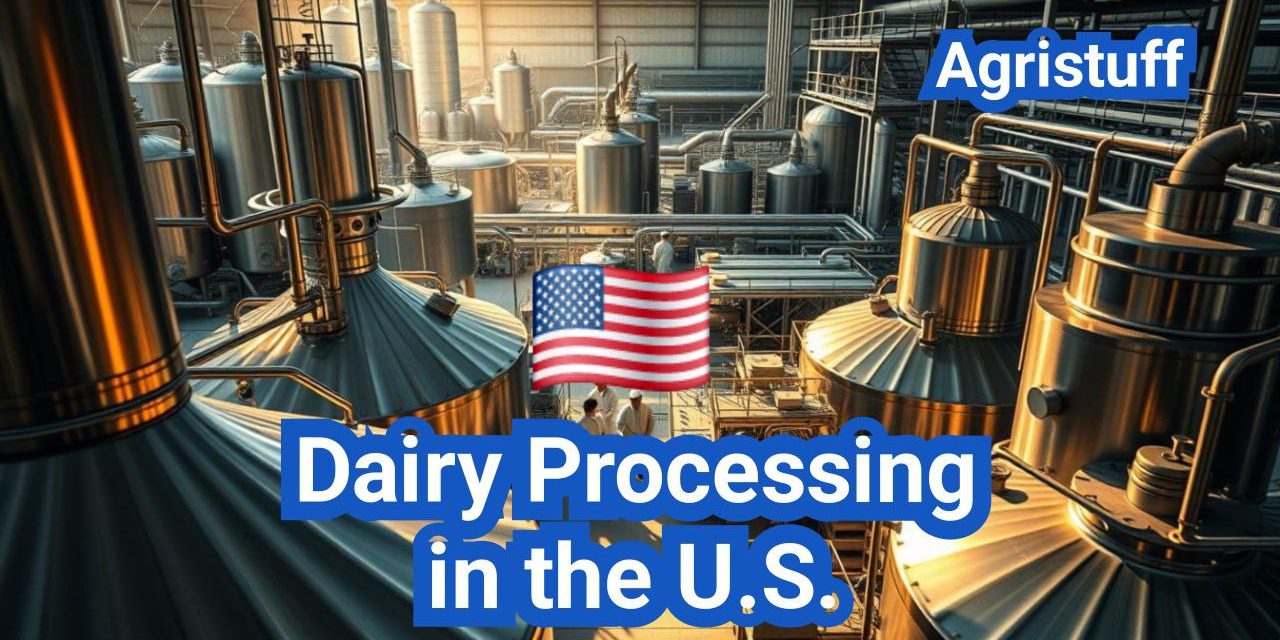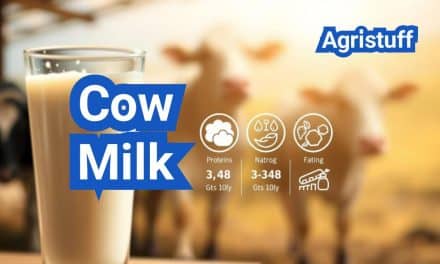The United States dairy industry is renowned for its stringent quality control measures and advanced HTST pasteurization techniques, ensuring the production of high-quality dairy products.
Dairy products undergo several critical steps, including pasteurization, separation, and standardization, to guarantee safety and quality.
The U.S. Department of Agriculture emphasizes the importance of these processes in producing safe dairy products, with regular testing for bacterial counts and somatic cell counts being a crucial aspect of quality control.
Key Takeaways
- HTST pasteurization is a critical step in dairy processing.
- Quality control measures ensure the safety of dairy products.
- Milk standardization is essential for consistent product quality.
- The U.S. dairy industry adheres to stringent regulations.
- Regular testing is conducted to monitor bacterial counts and somatic cell counts.
The Fundamentals of Dairy Processing in the United States
Understanding the fundamentals of dairy processing is crucial for appreciating the industry’s dynamics. The U.S. dairy industry is a complex network involving various stakeholders from farmers to consumers.
Overview of the U.S. Dairy Industry
The U.S. dairy industry is a significant sector within the country’s agricultural landscape. It encompasses milk production, processing, and distribution of various dairy products. The industry is characterized by its diversity, with dairy farms and processing facilities located across different regions.
Key aspects of the U.S. dairy industry include:
- Milk production on dairy farms
- Processing of milk into various dairy products
- Distribution and marketing of dairy products
From Farm to Table: The Dairy Supply Chain
The dairy supply chain is a critical component of the industry, involving multiple stakeholders. It begins with dairy farmers producing milk, which is then processed into various dairy products by dairy processors. These products are subsequently distributed to retailers and eventually consumed by end-users.
The supply chain can be broken down into several key stages:
- Raw milk production on dairy farms
- Raw milk collection and transportation to processing facilities
- Processing of milk into dairy products
- Packaging and distribution of dairy products
- Retail and consumption
Key Stakeholders in American Dairy Processing
The dairy processing industry involves various stakeholders, each playing a crucial role. These include:
| Stakeholder | Role |
|---|---|
| Dairy Farmers | Produce raw milk |
| Dairy Processors | Process raw milk into dairy products |
| Distributors and Retailers | Distribute and sell dairy products to consumers |
Understanding the roles of these stakeholders is essential for appreciating the complexity of the dairy supply chain and the industry as a whole.
Modern Dairy Processing Plants: Design and Operations

The design and operation of modern dairy processing plants play a crucial role in ensuring the quality and safety of dairy products. These facilities are designed with efficiency and safety in mind, incorporating advanced technologies for pasteurization, separation, and packaging.
Essential Components of a Dairy Processing Facility
A modern dairy processing plant consists of several essential components, including raw milk reception areas, processing equipment, packaging lines, and storage facilities. Efficient design of these components is critical for maintaining product quality and ensuring compliance with regulatory requirements.
The raw milk reception area is equipped with advanced testing equipment to assess the quality of incoming milk. This is followed by processing equipment such as pasteurizers, separators, and homogenizers, which are designed to optimize product quality and yield.
Flow Patterns and Process Integration
Effective flow patterns and process integration are vital for the efficient operation of a dairy processing plant. This involves designing the plant layout to minimize product handling, reduce contamination risks, and optimize production workflows.
Process integration involves combining various processing steps to streamline production. For example, integrating pasteurization and packaging can reduce the risk of contamination and improve product shelf life.
Regulatory Requirements for Plant Design
Dairy processing plants must comply with stringent regulatory requirements related to sanitation, safety, and environmental impact. Regulatory compliance is ensured through the incorporation of design features such as clean-in-place systems, effluent treatment plants, and safety interlocks.
As stated by a leading industry expert, “The design of a dairy processing plant must balance efficiency, quality, and regulatory compliance to ensure the production of safe and high-quality dairy products.” This highlights the importance of careful planning and design in modern dairy processing plants.
Raw Milk Reception and Initial Treatment
Raw milk reception is a critical step in dairy processing, setting the stage for quality control and initial treatment. The quality of raw milk upon reception at dairy processing plants is crucial for producing high-quality dairy products.
Quality Assessment of Incoming Raw Milk
The quality assessment of raw milk involves several tests to determine its suitability for processing. Key parameters include bacterial counts and somatic cell counts, which are indicative of milk quality and cow health.
| Test Parameter | Description | Acceptable Limit |
|---|---|---|
| Bacterial Counts | Measures the total viable bacteria in the milk | <100,000 CFU/mL |
| Somatic Cell Counts | Indicates the presence of somatic cells, related to cow health | <400,000 cells/mL |
As emphasized by dairy industry experts, “The quality of raw milk is paramount for the production of safe and high-quality dairy products.” Proper handling and storage are critical in maintaining these quality parameters.
Storage Conditions and Temperature Control
Proper storage conditions and temperature control are essential for maintaining the quality of raw milk. Storage tanks are designed to keep the milk at a consistent refrigerated temperature.
Temperature Control Measures:
- Refrigerated storage tanks
- Continuous agitation to prevent cream separation
- Monitoring systems for temperature and tank conditions
Preliminary Processing Steps
Before further processing, raw milk undergoes preliminary steps such as clarification and standardization. These steps ensure that the milk is clean and its composition is adjusted according to the requirements of the final product.
“Clarification removes impurities and sediment, while standardization adjusts the fat content to meet product specifications.”
Preliminary processing steps are crucial for ensuring the consistency and quality of the final dairy products.
Pasteurization Technologies and Techniques

Pasteurization technologies have evolved significantly, offering a range of methods to suit different dairy processing needs. The choice of pasteurization technique depends on the type of dairy product, desired shelf life, and equipment available.
HTST Pasteurization Systems
High-Temperature Short-Time (HTST) pasteurization is widely used for fluid milk products. This method involves heating milk to at least 161°F (72°C) for a minimum of 15 seconds, followed by rapid cooling. HTST pasteurization is effective in killing harmful bacteria while preserving the nutritional and sensory qualities of milk.
UHT and Aseptic Processing
Ultra-High Temperature (UHT) processing involves heating milk to a very high temperature (usually around 280°F or 138°C) for a short period (typically 2-5 seconds), followed by aseptic packaging. This method is used for products that require a long shelf life without refrigeration. UHT processing allows for the production of milk products with extended shelf life, making them convenient for consumers.
Vat Pasteurization for Specialty Products
Vat pasteurization, also known as batch pasteurization, involves heating milk in a vat or tank to a lower temperature (usually around 145°F or 63°C) for a longer period (typically 30 minutes). This method is often used for specialty products, such as certain types of cheese and yogurt, where the unique conditions can enhance flavor and texture.
Validation and Monitoring of Pasteurization Effectiveness
Validation and monitoring of pasteurization effectiveness are critical to ensuring the safety of dairy products. This involves regular testing for proper temperature control and the absence of harmful bacteria. Effective pasteurization validation helps dairy processors maintain high-quality products and comply with regulatory requirements.
In conclusion, various pasteurization technologies are employed in the dairy industry, each with its specific applications and benefits. Understanding these technologies is essential for dairy processors to produce safe and high-quality products.
Separation and Standardization Processes
Separation and standardization are critical processes in dairy processing that ensure the quality and consistency of dairy products. These processes are fundamental in achieving the desired characteristics in various dairy products.
Centrifugal Separation Technology
Centrifugal separation is a widely used method in dairy processing for separating cream from skim milk. This technology utilizes centrifugal force to differentiate components based on their density.
Key Benefits of Centrifugal Separation:
- High efficiency in separating cream from skim milk
- Ability to handle large volumes of milk
- Flexibility in adjusting separation parameters
Milk Fat Standardization Methods
Milk fat standardization involves adjusting the fat content of milk to desired levels, ensuring consistency across dairy products. This process is crucial for producing products like whole milk, reduced-fat milk, and cream.
The standardization process typically involves:
- Analyzing the fat content of incoming milk
- Adjusting the fat content by adding or removing cream
- Ensuring the final product meets the required fat content standards
Cream Processing and Utilization
Cream processing is an essential aspect of dairy processing, as it allows for the production of various cream-based products. The utilization of cream can significantly impact the overall profitability of a dairy operation.
Some common cream products include:
| Cream Product | Description | Fat Content |
|---|---|---|
| Cream | Used in various dairy and culinary applications | 18%-40% |
| Whipped Cream | A dessert topping | 30%-36% |
| Sour Cream | Used as a condiment or in baking | 18%-20% |
Homogenization in Dairy Processing
Homogenization is a critical process in dairy processing that ensures the uniform distribution of fat molecules in milk and dairy products. This process improves the overall quality and shelf life of dairy products.
Principles of Homogenization
The principle behind homogenization involves forcing milk through a small orifice under high pressure, typically between 10-20 MPa, to break down fat globules. This process results in a more stable emulsion, preventing cream separation and improving the product’s texture.
The homogenization process can be achieved through different methods, including single-stage and two-stage homogenization. In single-stage homogenization, the milk is forced through the homogenization valve once, while in two-stage homogenization, the milk is passed through two homogenization valves in series.
Equipment Types and Pressure Systems
Homogenization equipment varies in design and functionality, with the most common type being the high-pressure homogenizer. This equipment consists of a high-pressure pump and a homogenization valve.
- High-Pressure Homogenizers: These are the most commonly used homogenizers in dairy processing, capable of generating pressures up to 60 MPa.
- Ultrasonic Homogenizers: These use high-frequency sound waves to create cavitation, breaking down fat globules.
- Microfluidizers: These devices use a combination of high pressure and micro-channel flow to achieve homogenization.
Effects on Product Quality and Shelf Life
Homogenization significantly impacts the quality and shelf life of dairy products. By reducing the size of fat globules, homogenization improves the product’s texture and stability.
The benefits of homogenization include:
- Improved product consistency and appearance
- Enhanced flavor distribution
- Increased stability against cream separation
- Extended shelf life due to reduced bacterial growth on fat globules
In conclusion, homogenization is a vital process in dairy processing that enhances the quality and shelf life of dairy products. By understanding the principles, equipment, and effects of homogenization, dairy manufacturers can produce high-quality products that meet consumer expectations.
Advanced Membrane Filtration Technologies in Dairy Processing

Advanced membrane filtration technologies have become a cornerstone in modern dairy processing, enhancing product quality and shelf life. These technologies play a crucial role in various stages of dairy processing, from concentration and purification to fractionation and standardization.
Ultrafiltration Systems for Milk Processing
Ultrafiltration is widely used in the dairy industry for concentrating milk proteins. This process involves forcing the milk through a semi-permeable membrane with pore sizes that allow water and low molecular weight compounds to pass through while retaining larger molecules like proteins. Ultrafiltration is particularly useful for producing high-protein dairy products and improving the efficiency of cheese production.
Microfiltration Applications
Microfiltration is another critical membrane filtration technology used in dairy processing. It is primarily employed for removing bacteria and spores from milk, thereby enhancing its safety and extending its shelf life. The process involves membranes with larger pore sizes than ultrafiltration, allowing for the removal of microbial contaminants without significantly affecting the nutritional content of the milk.
“The use of microfiltration in dairy processing has been shown to significantly reduce the bacterial load in milk, improving its quality and safety.” – Dairy Processing Expert
Reverse Osmosis and Nanofiltration in Dairy
Reverse osmosis and nanofiltration are also utilized in the dairy industry for various applications. Reverse osmosis is used for concentrating dairy products by removing water, while nanofiltration is employed for fractionating and purifying dairy components. These technologies help in producing a range of dairy products with improved quality and consistency.
The integration of advanced membrane filtration technologies in dairy processing has revolutionized the industry, enabling the production of high-quality dairy products with enhanced safety and shelf life. As the dairy industry continues to evolve, the adoption of these technologies is expected to grow, driving further innovations in dairy processing.
Fermentation Processes in Dairy Manufacturing

Fermentation technology is fundamental to the dairy industry, facilitating the creation of numerous dairy products. This process involves the action of microorganisms or their enzymes on milk or milk products, resulting in a variety of fermented dairy products.
Yogurt Production Technology
Yogurt production involves fermenting milk with specific bacterial cultures, typically Lactobacillus bulgaricus and Streptococcus thermophilus. The fermentation process not only thickens the milk but also gives yogurt its characteristic taste and texture. Modern yogurt production facilities employ advanced technologies to control the fermentation conditions, such as temperature and pH, to ensure consistent product quality.
Cheese Manufacturing Processes
Cheese manufacturing involves a more complex fermentation process compared to yogurt. It requires the use of various cultures and enzymes to coagulate milk, followed by a series of steps including curdling, shaping, and aging. The type of cheese produced depends on factors like the type of milk used, the bacterial cultures, and the aging process. For instance, cheddar cheese production involves a mesophilic fermentation process, whereas mozzarella production requires a thermophilic process.
Starter Cultures and Fermentation Control
Starter cultures are crucial in dairy fermentation processes, as they contain the bacteria necessary for converting milk sugar (lactose) into lactic acid. The selection and control of starter cultures are vital for the quality and consistency of fermented dairy products. Modern dairy manufacturers use advanced techniques for starter culture preparation and fermentation control, including precise temperature control and monitoring of pH levels, to ensure optimal fermentation conditions.
The control of fermentation is critical to producing high-quality dairy products. This involves not only the selection of appropriate starter cultures but also the control of environmental conditions during fermentation. By carefully managing these factors, dairy manufacturers can produce a wide range of products with consistent quality and characteristics.
Dairy Processing Equipment Selection and Maintenance

Selecting the right dairy processing equipment and maintaining it properly are key factors in the dairy processing industry. The efficiency and quality of dairy processing operations heavily depend on the equipment used and how well it is maintained.
Critical Equipment for Different Dairy Products
Different dairy products require specific types of processing equipment. For instance, pasteurizers are essential for products that need to be pasteurized, such as milk and some yogurts. Homogenizers are used for products like homogenized milk and certain types of cheese to ensure uniform fat distribution.
Key Equipment Types:
- Pasteurizers (HTST and UHT)
- Homogenizers
- Centrifugal separators
- Membrane filtration systems
The selection of equipment depends on the type of dairy product being manufactured, the scale of production, and the desired product characteristics.
Preventative Maintenance Programs
Regular maintenance is crucial for ensuring the longevity and efficiency of dairy processing equipment. Preventative maintenance programs help in identifying potential issues before they become major problems, reducing downtime and improving product quality.
| Maintenance Activity | Frequency | Benefit |
|---|---|---|
| Cleaning and sanitizing | Daily/After each use | Prevents contamination |
| Inspection of seals and gaskets | Weekly | Reduces risk of leakage |
| Lubrication of moving parts | Monthly | Extends equipment life |
Upgrading Legacy Systems
Upgrading legacy dairy processing equipment can significantly improve efficiency, reduce energy consumption, and enhance product quality. Modern equipment often incorporates advanced technologies that can automate processes, improve precision, and reduce waste.
Considerations for Upgrading:
- Compatibility with existing systems
- Cost-benefit analysis
- Training for personnel
By carefully selecting and maintaining dairy processing equipment, manufacturers can ensure the production of high-quality dairy products while minimizing operational costs and environmental impact.
Clean-in-Place (CIP) Systems and Sanitation

In the dairy processing industry, Clean-in-Place (CIP) systems are indispensable for ensuring equipment cleanliness without the need for disassembly. These systems are crucial for maintaining high standards of hygiene and preventing contamination.
CIP Design and Operation
CIP systems are designed to clean equipment in place using a combination of cleaning agents, water, and sanitizing protocols. The design of a CIP system involves several key components, including:
- Tanks for storing cleaning solutions and water
- Pumps for circulating the cleaning solutions through the equipment
- Pipes and valves for distributing the cleaning solutions
- Spray balls or nozzles for ensuring thorough coverage of equipment surfaces
The operation of a CIP system typically involves a series of cycles, including pre-rinse, cleaning, rinse, and sanitizing. Each cycle is designed to remove different types of contaminants and ensure the equipment is thoroughly cleaned and sanitized.
Sanitizing Agents and Protocols
Sanitizing agents play a critical role in CIP systems by reducing microbial contamination on equipment surfaces. Common sanitizing agents used in dairy processing include:
- Chlorine-based sanitizers
- Quaternary ammonium compounds (quats)
- Peracetic acid
The choice of sanitizing agent depends on factors such as the type of equipment being cleaned, the level of contamination, and regulatory requirements. Sanitizing protocols must be carefully validated to ensure their effectiveness.
Validation of Cleaning Effectiveness
Validation of CIP system effectiveness is crucial to ensure that equipment is properly cleaned and sanitized. This involves regular testing for contaminants, such as Escherichia coli and other coliform bacteria, as well as monitoring the CIP system’s operational parameters, like temperature, flow rate, and chemical concentration.
Effective validation requires a comprehensive program that includes:
- Regular swab testing of equipment surfaces
- Monitoring of CIP system performance
- Training of personnel on CIP system operation and maintenance
By implementing a robust CIP system and adhering to stringent sanitation protocols, dairy processors can ensure the production of high-quality, safe products while maintaining compliance with regulatory requirements.
Quality Control in Dairy Processing

Maintaining high standards of quality control is essential in the dairy processing sector to protect consumer health and ensure the production of safe, high-quality dairy products.
Statistical Process Control (SPC) and Coliform Testing Procedures
Statistical Process Control (SPC) is a critical component of quality control in dairy processing. It involves the use of statistical methods to monitor and control processes, ensuring that they operate within predetermined limits. SPC helps in early detection of deviations, allowing for timely corrective actions to prevent product spoilage or contamination.
Coliform testing is another vital quality control measure. It is used to detect the presence of coliform bacteria, which can indicate potential contamination. Regular coliform testing helps dairy processors maintain high hygiene standards and prevent the production of contaminated products.
| Testing Method | Purpose | Frequency |
|---|---|---|
| SPC | Monitor process control | Continuous |
| Coliform Testing | Detect contamination | Regular intervals |
Phosphatase Testing for Pasteurization Verification
Phosphatase testing is used to verify the effectiveness of pasteurization. The test detects the presence of alkaline phosphatase, an enzyme naturally present in raw milk. Proper pasteurization inactivates this enzyme; thus, its presence or absence is a reliable indicator of whether milk has been adequately pasteurized.
Environmental Monitoring Programs
Environmental monitoring programs are essential for detecting potential sources of contamination within dairy processing facilities. These programs involve regular sampling and testing of environmental surfaces to identify areas that may harbor harmful bacteria or other contaminants.
Product Sampling and Testing Protocols
Product sampling and testing are critical components of quality control. Dairy processors must implement robust sampling protocols to ensure that products are tested for various parameters, including microbiological contaminants, compositional accuracy, and sensory characteristics.
| Parameter | Testing Method | Acceptance Criteria |
|---|---|---|
| Microbiological Contaminants | Plate count methods | Within regulatory limits |
| Compositional Accuracy | Infrared spectroscopy | Meets product specifications |
| Sensory Characteristics | Sensory panels | Meets quality standards |
Regulatory Compliance for U.S. Dairy Processors

Regulatory compliance is a critical aspect of dairy processing in the U.S., involving adherence to various federal and state regulations. Dairy processors must navigate a complex landscape of standards to ensure the production of safe and high-quality dairy products.
FDA Requirements and Inspections
The FDA sets stringent requirements for dairy processors, including standards for pasteurization, sanitation, and product labeling. Regular inspections are conducted to ensure compliance with these regulations.
- Pasteurization protocols must be validated to ensure the elimination of harmful pathogens.
- Sanitation practices are scrutinized to prevent contamination.
- Labeling must comply with FDA guidelines, including accurate nutritional information.
EPA 40 CFR Part 405 Effluent Guidelines
The Environmental Protection Agency (EPA) regulates wastewater discharge from dairy processing facilities through the 40 CFR Part 405 Effluent Guidelines. These guidelines aim to minimize the environmental impact of dairy processing operations.
Key aspects of EPA regulations include:
- Limitations on the discharge of pollutants into waterways.
- Requirements for the treatment and management of wastewater.
- Monitoring and reporting obligations to ensure compliance.
State-Level Regulations and Compliance
In addition to federal regulations, dairy processors must also comply with state-level regulations, which can vary significantly. These regulations may cover aspects such as milk sourcing, production practices, and environmental impact.
Dairy processors must work closely with state authorities to ensure compliance with these regulations, which are often enforced through regular inspections and audits.
Sustainability in Dairy Processing Operations

As concerns about climate change and resource depletion grow, sustainability in dairy processing has gained significant attention. Dairy processors are now focusing on reducing their environmental footprint while maintaining operational efficiency.
ENERGY STAR Certification for Dairy Plants
One way dairy processors are achieving sustainability is through ENERGY STAR certification. This recognition is awarded to plants that demonstrate superior energy efficiency. By implementing energy-saving technologies and practices, dairy processors can significantly reduce their energy consumption.
ENERGY STAR certification involves a comprehensive evaluation of a plant’s energy performance. It considers various factors, including the type of equipment used, production processes, and overall energy management practices. Achieving this certification not only reduces operational costs but also enhances the plant’s reputation as an environmentally responsible entity.
Water Conservation Strategies
Water conservation is another critical aspect of sustainability in dairy processing. Processors are implementing various strategies to reduce water usage, such as installing water-saving equipment and implementing water recycling programs.
Effective water conservation strategies can significantly reduce the amount of water used in dairy processing. This not only helps in conserving this vital resource but also reduces the energy required for water treatment and heating, thereby lowering operational costs.
Waste Management and Byproduct Utilization
Efficient waste management is crucial for sustainable dairy processing. Processors are focusing on minimizing waste and maximizing the utilization of byproducts. This includes using whey from cheese production for various applications, such as animal feed or nutritional supplements.
By adopting effective waste management practices, dairy processors can reduce their environmental impact while creating additional revenue streams from byproduct utilization. This approach not only enhances sustainability but also improves the overall economic viability of dairy processing operations.
The Future of Dairy Processing in America
The American dairy industry is poised for continued growth and innovation, driven by advancements in technology and shifting consumer preferences. As dairy processing trends evolve, the industry is likely to adopt more sustainable practices, leveraging technologies that reduce energy consumption and waste.
Future dairy processing plants will incorporate cutting-edge technologies, such as advanced membrane filtration and homogenization techniques, to improve product quality and safety. The industry will also focus on meeting changing consumer demands, including the development of more environmentally friendly packaging and products with enhanced nutritional profiles.
Regulatory developments will play a crucial role in shaping the future of dairy processing in America. As the industry continues to evolve, it is essential that processors stay informed about emerging trends and regulatory requirements to remain competitive. By embracing innovation and sustainability, the American dairy industry can maintain its position as a leader in the global market.
FAQ
What is dairy processing, and why is it important?
Dairy processing involves transforming raw milk into various dairy products, ensuring they are safe for consumption. It’s crucial for producing high-quality dairy products and maintaining public health.
What is pasteurization, and how does it work?
Pasteurization is a process that involves heating milk to a high temperature to kill harmful bacteria. Different pasteurization technologies, such as HTST and UHT, are used to achieve this.
What is the role of homogenization in dairy processing?
Homogenization is a process that creates a uniform texture in milk and dairy products by breaking down fat molecules. It improves the quality and shelf life of dairy products.
How is raw milk quality assessed upon reception at dairy processing plants?
Raw milk quality is assessed through testing for various parameters, including bacterial counts and somatic cell counts, to ensure it meets quality standards.
What is the significance of Clean-in-Place (CIP) systems in dairy processing?
CIP systems are essential for maintaining sanitation in dairy processing plants by cleaning equipment in place without disassembly, ensuring the removal of contaminants and preventing bacterial growth.
How do dairy processors ensure regulatory compliance?
Dairy processors comply with FDA regulations, EPA effluent guidelines, and state-level regulations to ensure the production of safe and high-quality dairy products.
What is the importance of sustainability in dairy processing operations?
Sustainability is becoming increasingly important in dairy processing, with a focus on energy efficiency, water conservation, waste management, and byproduct utilization to reduce the environmental footprint.
What are the different types of membrane filtration technologies used in dairy processing?
Advanced membrane filtration technologies, including ultrafiltration, microfiltration, reverse osmosis, and nanofiltration, are used to improve the quality and shelf life of dairy products.
How is fermentation used in dairy manufacturing?
Fermentation is used to produce a variety of dairy products, including yogurt and cheese, by fermenting milk with specific bacterial cultures and enzymes.
What is the role of quality control in dairy processing?
Quality control involves various measures, including SPC and coliform testing, phosphatase testing, environmental monitoring, and product sampling and testing, to ensure the production of safe and high-quality dairy products.
Conclusion of: Dairy Processing In USA
Why dairy processing matters in the U.S. food system
Dairy processing underpins a safe, reliable supply of milk, yogurt, cheese, butter, and powders for more than 300 million American consumers. By converting raw milk into standardized, packaged foods, dairy processing safeguards public health, stabilizes quality, and enables nationwide distribution. It is governed by federal and state rules, modern engineering controls, and rigorous labs to control hazards from farm pickup through packaging — an integrated chain designed so that Grade “A” products stay safe and consistent from plant to shelf. FDA — Pasteurized Milk Ordinance overview
The U.S. regulatory backbone for dairy processing
Two pillars frame compliance for dairy processing plants: the Grade “A” Pasteurized Milk Ordinance (PMO), which standardizes Grade “A” milk sanitation across states, and the FDA’s FSMA Preventive Controls for Human Food (21 CFR Part 117), which requires a written food safety plan, hazard analysis, and preventive controls. Together they set expectations for facilities, equipment design, testing, and documentation that keep processors inspection-ready and consumer-focused. FDA — FSMA Preventive Controls rule
From farm to silo: raw milk quality requirements that drive dairy processing
Raw milk quality is the first control point in dairy processing. Grade “A” limits for standard plate counts and somatic cell counts ensure incoming milk meets sanitary expectations; many states adopt or tighten these PMO thresholds. Processors also verify temperature and odor, and review farm and hauler records before unloading to protect product integrity and plant performance. California Dept. of Food & Agriculture — Milk Standards
Antibiotic residue screening under Appendix N
Every tanker is screened for drug residues before it enters dairy processing silos. PMO Appendix N requires validated, FDA-accepted rapid tests for beta-lactams and specifies corrective actions for positives, such as rejecting and tracing loads. This program protects the food supply, lab cultures, and downstream fermentation performance. FDA/NCIMS — Official PMO Regulatory Laboratory Tests (M-a-98)
Clarification and centrifugal separation
Before thermal treatment, dairy processing uses clarifiers to remove sediment, then separators to split cream from skim via high-speed discs. This step enables fat standardization, improves downstream heat exchange, and reduces fouling, all of which support stable flavor and shelf life. Univ. of Guelph — Clarification & cream separation
Legal identity and standardization targets
Standardization is where dairy processing meets law: U.S. “milk” in final package must contain ≥3.25% milkfat and ≥8.25% milk-solids-not-fat. Processors adjust fat by blending cream and skim to precise specs, then document results for label accuracy and regulatory review. 21 CFR 131.110 — Milk (LII)
Homogenization for stability and texture
Many products undergo homogenization during dairy processing to reduce fat globule size and prevent creaming. This mechanical step improves mouthfeel and color uniformity without changing composition, and labeling may note “homogenized” where applicable. CFR Part 131 (govinfo) — Milk & Cream standards
Pasteurization fundamentals: time–temperature that saves lives
Pasteurization is the core kill step in dairy processing. Plants use LTLT (63 °C/30 min) or HTST (72 °C/15 s) systems for fluid milk, with higher combinations for some products. These validated conditions deliver log-reductions of pathogens while preserving flavor and nutrients, and are continuously recorded and sealed against tampering. PMO Appendix H & pasteurization references
Verifying pasteurization with the phosphatase test
Because native alkaline phosphatase is heat-sensitive, dairy processing labs verify pasteurization by confirming ALP activity is at or below the public health threshold. Modern fluorometric/chemiluminescent methods rapidly detect residual ALP in finished product as a robust process check. PubMed — ALP limit of 350 mU/L in pasteurized milk
ESL, UHT, and aseptic packaging
To extend shelf life, dairy processing may combine higher-heat treatment (ESL/UHT) with aseptic fillers and sterilized packaging. Aseptic low-acid foods must meet FDA’s aseptic processing and packaging regulations and validation expectations, including detailed thermal delivery and sterility assurance records. 21 CFR 113 — Aseptic processing of low-acid foods
Cultured products and yogurt standards
Fermented dairy relies on controlled cultures in dairy processing. U.S. yogurt has a federal standard of identity with minimum milkfat and MSNF; processors manage heat-treats, inoculation, incubation, shear, and fruit inclusion to maintain texture and live cultures where claimed. FDA — Yogurt standard guidance (21 CFR 131.200)
Cheese making and hygienic equipment design
From coagulation to curd handling, dairy processing of cheese depends on hygienic design to avoid harborage. Smooth, cleanable surfaces, proper welds, and drainability (with CIP coverage) are supported by recognized sanitary standards that complement PMO and FSMA expectations. 3-A Sanitary Standards — Hygienic design
Membrane technologies (MF/UF/NF/RO)
Modern dairy processing widely applies membranes: microfiltration for bacteria/spore reduction and casein fractionation, ultrafiltration for protein concentration, nanofiltration for partial demineralization or lactose-free streams, and reverse osmosis for water removal. Integration boosts yields and quality across fluid milk, cheese, and whey lines. NIH/PMC — Membrane technologies in dairy
Evaporation and spray drying
When dairy processing targets powders (e.g., NFDM, WPC), multiple-effect evaporators gently concentrate solids before spray drying in filtered, temperature-controlled air. Robust thermal profiles, air handling, and inline moisture checks keep powders safe and free-flowing for long shelf life and export. UW Center for Dairy Research — Processing resources
Micro testing: SPC, coliforms, and shelf-life
Routine microbiology anchors dairy processing verification. Processors trend standard plate counts, coliforms, and environmental indicators to confirm good pasteurization, sanitation, and cold-chain control. PMO-aligned limits for pasteurized products (e.g., ≤20,000 SPC/mL, ≤10 coliforms/mL) are common regulatory benchmarks. California Milk Standards — SPC/coliform limits
Environmental monitoring and Listeria control
Because post-pasteurization areas are most vulnerable, dairy processing programs emphasize hygienic zoning and environmental monitoring for Listeria monocytogenes. Preventive controls include traffic flow, drain design, sanitation verifications, and rapid corrective actions for positives. FDA — Biological hazards & preventive controls
CIP, sanitizers, and residue compliance
Clean-in-place (CIP) lets dairy processing equipment be cleaned and sanitized with validated cycles and approved chemistries. Only sanitizing solutions cleared for food-contact surfaces may be used, and plants calibrate concentrations, contact times, and temperatures to meet label and regulatory requirements. 21 CFR 178.1010 — Sanitizing solutions
Water and wastewater responsibilities
Efficient water use and compliant discharge are essential parts of dairy processing. U.S. EPA’s Dairy Products Processing Effluent Guidelines (40 CFR Part 405) define technology-based limits for wastewater, guiding pretreatment, solids capture, and opportunities to reclaim condensate and CIP rinses. EPA — Dairy Products Processing Effluent Guidelines
Energy efficiency and decarbonization
Pasteurizers, refrigeration, compressed air, and dryers dominate the energy footprint of dairy processing. ENERGY STAR benchmarking and best-practice guides help plants lower steam, electricity, and refrigeration loads through heat recovery, VFDs, smart controls, and insulation upgrades. ENERGY STAR — Dairy processing focus
Ammonia refrigeration safety
Most U.S. dairy processing facilities use anhydrous ammonia for efficient cooling. OSHA’s guidance highlights hazard identification, PSM elements for covered systems (≥10,000 lb), operator training, and mechanical integrity to protect workers and neighborhoods. OSHA — Ammonia Refrigeration eTool
Building a FSMA-ready food safety plan
A strong dairy processing food safety plan maps product flow, pinpoints hazards (e.g., post-pasteurization contamination, allergen mislabeling), and sets up preventive controls and monitoring. Documentation, verification, and reanalysis keep the plan current as lines, products, or suppliers change. FDA — Preventive Controls guidance
Quality control meets consumer trust
Ultimately, dairy processing translates into consumer confidence: consistent nutrition, safe shelf life, and reliable flavor. Plants integrate SPC trends, customer complaints, phosphatase checks, cooler mapping, and label audits to assure specifications and close any gaps quickly. FDA — PMO program overview
Final thought
The U.S. model for dairy processing blends rigorous rules (PMO and FSMA), proven technologies (pasteurization, separation, membranes), and disciplined verification (ALP, SPC, coliforms, environmental monitoring). For processors, the roadmap is clear: design for hygiene, validate your kill steps, monitor relentlessly, and keep improving energy and water performance — so every carton, cup, and block reaches the consumer safe, compliant, and delicious. FDA — FSMA overview
Sources & References
For deeper reading that underpins the practices in dairy processing, explore these primary sources:
- FDA — Pasteurized Milk Ordinance (PMO) overview
- FDA/NCIMS M-a-98 — Official PMO Laboratory Tests
- 21 CFR 131.110 — Milk (LII)
- PubMed — ALP 350 mU/L public-health limit
- 21 CFR 113 — Aseptic processing (eCFR)
- FDA — Yogurt standard guidance (21 CFR 131.200)
- NIH/PMC — Membrane technologies in dairy
- 21 CFR 178.1010 — Sanitizing solutions
- EPA — Dairy Products Processing Effluent Guidelines
- ENERGY STAR — Dairy processing focus
- OSHA — Ammonia Refrigeration eTool
- CDFA — Milk Standards (SPC/coliform limits)
- UW Center for Dairy Research — Processing resources
- FDA — Preventive Controls guidance (FSMA)










